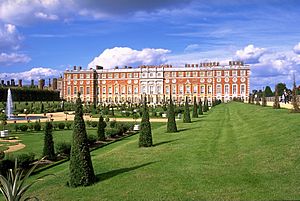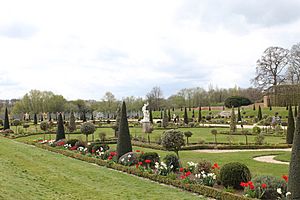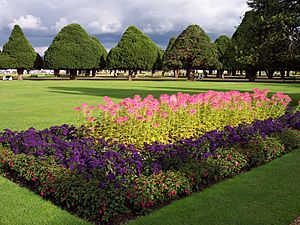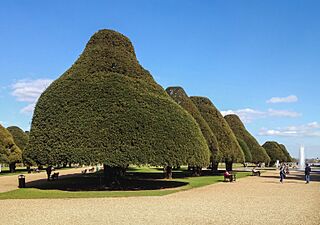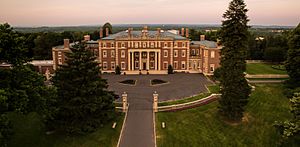Hampton Court Palace facts for kids
Quick facts for kids Hampton Court Palace |
|
|---|---|

The Tudor Great Gatehouse
|
|
| General information | |
| Location | Hampton Court, Greater London, England |
| Coordinates | 51°24′12″N 0°20′15″W / 51.40333°N 0.33750°W |
| Current tenants | Historic Royal Palaces |
| Owner | Charles III in right of the Crown |
|
Listed Building – Grade I
|
|
| Official name | Hampton Court Palace |
| Designated | 2 September 1952 |
| Reference no. | 1193127 |
Hampton Court Palace is a famous royal palace located in the London Borough of Richmond upon Thames, about 12 miles (19 km) southwest of central London. It sits right by the River Thames.
Building the palace started in 1514 for Cardinal Thomas Wolsey, who was a powerful advisor to King Henry VIII. In 1529, Wolsey gave the palace to the King. Henry VIII loved Hampton Court and made it even bigger to fit his many courtiers (people who worked for the King).
Later, in the 1690s, King William III began a huge project to rebuild and expand the palace. He wanted it to be as grand as the Palace of Versailles in France. This work changed much of the original Tudor palace. Today, Hampton Court Palace shows two very different styles: the older Tudor look and the grand Baroque style.
The palace is now a popular place for tourists to visit. An independent charity called Historic Royal Palaces takes care of the building and its beautiful gardens. You can see many amazing artworks from the Royal Collection here. Visitors also enjoy the famous maze, the historic royal tennis court, and a giant grape vine, which was the world's largest in 2005. The palace's park also hosts the annual Hampton Court Palace Festival and Hampton Court Garden Festival.
Contents
Discovering Hampton Court's Past
Early Days of Hampton Court
Before it became a royal palace, Hampton Court belonged to a group called the Knights Hospitaller. It was rented out to important people, including Sir Giles Daubeney in 1494. Daubeney made the buildings larger and built the Great Kitchens, which you can still see today. In 1514, Cardinal Thomas Wolsey took over the lease.
Tudor Times: Kings and Queens
Cardinal Thomas Wolsey started building his grand palace in 1514. He spent a lot of money to make it the finest palace in England. Wolsey's original courtyard, the Base Court (B on the map), and the inner gatehouse (C) leading to the Clock Court (D) were his creations. His private rooms were in the Clock Court (O).
Wolsey wanted his palace to look like the grand homes of cardinals in Italy. He used a mix of traditional English Tudor style and new Italian Renaissance designs. Italian artists helped add beautiful decorations, like the eight stone faces of Roman emperors by Giovanni da Maiano.
In 1529, Wolsey gave the palace to King Henry VIII. Wolsey died the next year. Henry VIII quickly began to make the palace even bigger. His court had over a thousand people, so he needed huge kitchens to feed everyone. He quadrupled the size of the kitchens in 1529.
Between 1532 and 1535, Henry added the magnificent Great Hall (J on the map). This was the last medieval great hall built for an English monarch. It has a stunning carved hammerbeam roof. The King would eat here at a special table.
In 1540, the gatehouse to the inner court got a special astronomical clock. This clock still works and shows the time, moon phases, month, and even the best time to travel by boat on the Thames. This gatehouse is sometimes called Anne Boleyn's Gate, named after Henry's second wife.
Many important events happened at Hampton Court during Tudor times. In 1537, King Henry's son, Edward VI, was born here. Sadly, his mother, Jane Seymour, died at the palace two weeks later. Years later, King Henry learned about problems with his fifth wife, Catherine Howard, while at the palace. She was later sent away.
Queen Mary I, Henry's older daughter, spent her honeymoon at Hampton Court with King Philip. She also stayed there for five months, thinking she was going to have a baby. After Mary, her half-sister, Elizabeth I, became Queen. Elizabeth had the eastern kitchen built, which is now a tea room.
Stuart and Hanoverian Kings and Queens
After Elizabeth I died in 1603, James I became king, starting the Stuart period. In 1604, the palace hosted the Hampton Court Conference, where King James met with religious leaders. This meeting led to the creation of the King James Version of the Bible.
King Charles I used Hampton Court as both a palace and a prison. After he was executed in 1649, Oliver Cromwell took over. Luckily, the palace was not destroyed during this time.
In 1689, King William III and Queen Mary II decided to rebuild Hampton Court. They wanted a grand new palace in the Baroque style, similar to Versailles. They hired the famous architect Sir Christopher Wren. Wren's design mixed pink bricks with pale stone, creating a unique look.
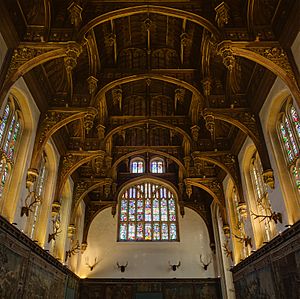
During this rebuilding, half of the old Tudor palace was replaced. New state apartments were built for the King and Queen, each with its own grand staircase. The King's staircase was decorated with beautiful paintings by Antonio Verrio.
After Queen Mary died, King William lost interest in the project. He later died in 1702 after falling from his horse in Hampton Court Park. Queen Anne continued some of the decorations.
George I and his son George II were the last monarchs to live at Hampton Court. Under George II, more rooms were updated with new designs by architect William Kent.
Hampton Court Today
No monarch has lived at Hampton Court since King George II. For many years, the palace was used to house "grace and favour" residents. These were people who were allowed to live there for free as a reward for their service to the Crown. Famous scientist Michael Faraday lived here from 1862 to 1867.
In 1838, during the reign of Queen Victoria, the palace was opened to the public. It quickly became a popular tourist spot. In 1986, a major fire damaged parts of the King's Apartments, but the palace was carefully restored by 1990.
In 2009, rock keyboardist Rick Wakeman performed his album The Six Wives of Henry VIII at the palace. Hampton Court was also a venue for the Road Cycling Time Trial during the 2012 Summer Olympics.
In 2015, Hampton Court celebrated its 500th anniversary with special historical shows. In 2016, the first Catholic church service in 450 years was held in the Chapel Royal.
Inside the Palace: Art and Treasures
Hampton Court Palace is home to many artworks and furnishings from the Royal Collection. These items mostly come from the Tudor period and the late Stuart to early Georgian times. You can find paintings, furniture, ceramics, and sculptures.
One of the most important artworks is Andrea Mantegna's Triumphs of Caesar, displayed in the Lower Orangery. The palace once held the famous Raphael Cartoons, which are now at the Victoria and Albert Museum. Copies of these cartoons are shown in the Cartoon Gallery. You can also see beautiful collections of ceramics, including blue and white porcelain collected by Queen Mary II.

Many original pieces of furniture from the late 1600s and early 1700s are still here. These include tables, chairs, clocks, and even some of the original state beds. The King's Privy Chamber has a crystal chandelier from around 1700, which might be the first of its kind in England.
The King's Guard Chamber has a large display of weapons like muskets, pistols, and swords, arranged in decorative patterns on the walls. Hampton Court also holds most of the Royal Ceremonial Dress Collection, with over 10,000 items of clothing, sketches, and historical documents.
The Chapel Royal

The Chapel's timber and plaster ceiling is considered one of the most important and beautiful in Britain. It is the only part that remains from the original Tudor decoration. The altar has a grand oak screen carved by Grinling Gibbons. The royal family would sit in a special pew upstairs to attend services, separate from everyone else.
The term Chapel Royal refers to the group of clergy and musicians who serve the monarch, not just the building itself.
Exploring the Gardens and Grounds
The gardens you see today were mostly designed in the late 1600s. There are no original gardens left from Henry VIII's time, only a small knot garden planted in 1924 that gives a hint of how they might have looked.
A major feature is the grand design created for Sir Christopher Wren's new palace. From the east front, three long avenues spread out like a crow's foot. The middle avenue has a large canal called the Long Water, dug in 1662. This design was inspired by the famous Gardens of Versailles in France.
On the south side of the palace is the Privy Garden, with beautiful wrought iron gates by Jean Tijou. This garden, once King William III's private space, was replanted in 1992 to look like it did in his time, with carefully shaped hollies and yew trees.
A small building called the Banqueting House sits overlooking the Thames. It was built around 1700 for informal meals and parties in the gardens. Nearby, a conservatory houses the "Great Vine," planted in 1769. This huge vine still produces grapes every year!
A fun part of the palace grounds is the Hampton Court Maze. It was planted in the 1690s and was originally made of hornbeam hedges. Today, it has been repaired with different types of hedges.
In 2009, a new "Tudor Garden" was created to celebrate Henry VIII's 500th anniversary. It's filled with 16th-century flowers and herbs, along with gilded animal statues and green and white fences.
The formal gardens and park are considered very important historically.
The King's Beasts
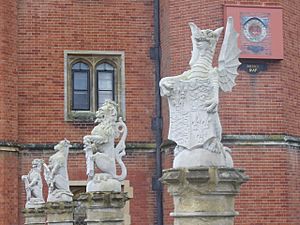
On the bridge leading to the main gatehouse, you'll see ten statues of heraldic animals called the King's Beasts. These statues represent the family history of King Henry VIII and his third wife, Jane Seymour. The animals include the lion of England, the royal dragon, the black bull of Clarence, and the yale of Beaufort.
In 2009, for Henry VIII's 500th anniversary, eight smaller wooden King's Beasts were carved for the new Tudor Garden. These colorful statues, carved from English oak, include the golden lion of England and the red dragon of Wales.
Getting to Hampton Court
The palace is easy to reach by train, which is right next to Hampton Court Bridge. You can also get there by London bus routes 111, 216, 411, and R68 from Kingston and Richmond.
Hampton Court in Culture
Inspired Buildings
The American Vanderbilt family built their estate, Florham, in New Jersey, to look like Sir Christopher Wren's design at Hampton Court. It was built in 1893.
Filming Location
Hampton Court Palace has been a popular location for many movies and TV shows. Some of these include The Private Life of Henry VIII, A Man For All Seasons, The Young Victoria, Pirates of the Caribbean: On Stranger Tides, Cinderella, The Favourite, Bridgerton, and Queen Charlotte: A Bridgerton Story.
See also
 In Spanish: Hampton Court para niños
In Spanish: Hampton Court para niños
- List of works of art at Hampton Court Palace
- Hampton Court ghost





